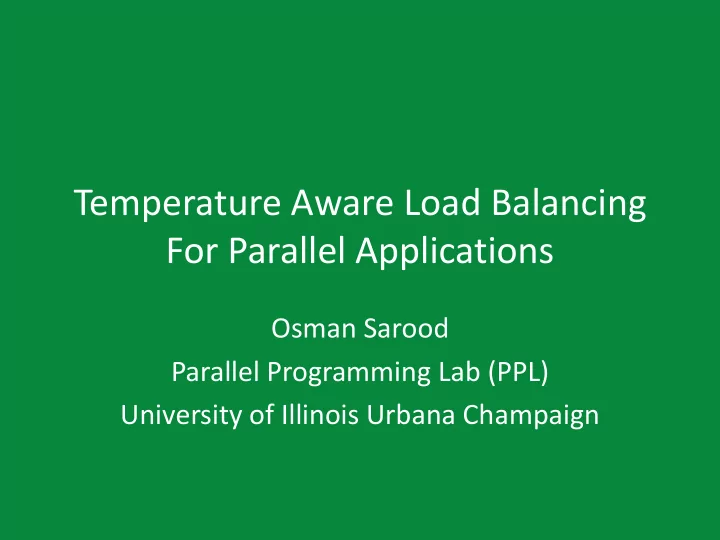

Temperature Aware Load Balancing For Parallel Applications Osman Sarood Parallel Programming Lab (PPL) University of Illinois Urbana Champaign
Why Energy? • Data centers consume 2% of US Energy Budget in 2006 • Costed $4.1 billion consumed 59 billion KWh • The 3 ‐ year cost of powering and cooling servers exceeds the cost of purchasing the server hardware • 2.5X system level power efficiency improvement in last three years (100X needed for exascale) 2
Why Cooling? • Cooling accounts for 50% of total cost • Most data centers face HotSpots responsible for lower temperatures in machine rooms • Data center managers can save*: – 4% (7%) for every degree F (C) – 50% going from 68F(20C )to 80F(26.6C) • Room temperatures can be increased provided: – No Hotposts – Cores temperatures don’t get too high *according to Mark Monroe of Sun Microsystem 3
Core Temperatures Hotspot! *CRAC stands for Computer Room Air Conditioning • Reducing cooling results for Wave2D: – Difference of 6C in average temperature – Difference of 12C in deviation from average 4
Constraining Core Temperatures using DVFS • Periodic check on core Normalization w.r.t all cores running at maximum frequency temperatures without temperature control • Timing penalty grows with a decrease in cooling • Machine energy increases as well! • Not useful due to tightly coupled nature of applications 5
Temperature Aware Load Balancer • Specify temperature threshold and sampling interval • Runtime system periodically checks core temperatures • Scale down/up if temperature exceeds/below maximum threshold at each decision time • Transfer tasks from slow cores to faster ones 6
Charm++ • Object ‐ based over ‐ decomposition – Helpful for refinement load balancing • Migrateable objects – Mandatory for our scheme to work • Time logging for all objects – Central to load balancing decisions 7
Experimental Setup • 128 cores (32 nodes), 10 different frequency levels (1.2GHz – 2.4GHz) • Direct power measurement • Dedicated CRAC • Power estimation based on P ac = f ac * c air *( T hot + T ac ) • Applications: Jacobi2D, Mol3D, and Wave2D – Different power profiles • Max threshold: 44C 8
Average Core Temperatures in Check • Avg. core temperature within 1 ‐ 2 C of threshold • Can handle applications having different temperature gradients 9
Hotspot Avoidance • Without our scheme Wave2D on 128 Cores max. difference: – Increases over time – Increases with CRAC set point • With our scheme – Max. temperature decreases with time – Insensitive to CRAC set point • Our scheme avoids Hotspots Hot Spots Avoided! 10
Timing Penalty Jacobi2D on 128 Core • Our load balancer performs better • Decrease in cooling, increases: – Timing penalty – Advantage of our scheme 11
Processor Timelines for Wave2D Idle Time No TempLB • Shows processor utilization during execution time (green and pink correspond to computations) • Execution time dependent on slowest core • One core can cause timing penalty/slowdown 12
Minimum Frequency (No TempLB) • Frequency of slowest core for (CRAC 23.3C) • Wave2D and Mol3D – Lower minimum frequencies – Higher timing penalties Application Time Penalty(%) Wave 38 Mol3D 28 Jacobi2D 23 13
Timing Overhead • Dependent on: – How frequently temperatures checked – How many migrations • Wave2D has the highest migration percentage 14
Timing Penalty and CRAC Set Point • Slope: timing penalty (secs) per 1C increase in CRAC set point • Correlation between Timing penalty and MFLOP/s Application MFLOP/s Wave 292 Mol3D 252 Jacobi2D 240 15
Machine Energy Consumption Mol3D on 128 Cores • Our scheme consistently saves machine power in comparison to `w/o TempLB’. • High idle power coupled with timing penalty doesn’t allow machine energy savings. 16
Cooling Energy Consumption Jacobi2D on 128 Cores • Both schemes save energy (TempLDB better) • Our scheme saves upto 57% 17
Timing Penalty/ Total Energy Savings Jacobi2D on 128 Cores • Mol3D and Jacobi2D show good energy savings • Wave2D not appropriate for energy savings? 18
Temperature range instead of Threshold • Temperature Range: 44C – 49C • Scale down if core temperature > upper limit • Scale up if core temperature < lower limit CRAC Set Timing Timing Power Saving: Power Saving: Point Penalty: Penalty: Range (%) Threshold (%) Range (%) Threshold(%) 23.3 3 15 19 11 25.6 12 22 23 20 19
Energy Vs Execution Time Mol3D on 128 Cores Normalization w.r.t all cores running at maximum frequency without temperature control • Our scheme brings green line to red line – Moving left: saving total energy – Moving down: saving execution time penalty • Slope: timing penalty (secs) per joule saved in energy 20
Contributions • Stabilizing core temperatures • Avoiding Hotspot • Minimize timing penalty/ slowdown • Minimize Cooling costs – Saved 48% cooling moving from 18.9C – 25.6C 21
Questions 22
Machine Energy Consumption 23
Cooling Energy Savings 24
Timing Penalty/ Total Energy Savings 25
Energy Vs Execution Time 26
Average Frequency • Mol3D’s average frequency lower than Jacobi even with less power/CPU utilization • High total power for Jacobi • Greater number of DRAM accesses • Overall large memory footprint • High MFLOP/s for Mol3D considering low CPU utilization • Data readily available in L1+L2 27
Cooling Energy Savings Jacobi Mol3D Wave2D TempLB No TempLB TempLB No TempLB TempLB No TempLB 57 0.83008303 0.92662993 0.9535189 0.9825494 1.08436118 1.10835359 62 0.91371415 0.91630064 1.02676076 0.94843724 0.94017829 0.94566919 66 0.87636352 0.95424306 0.89537819 0.95016447 0.89775714 0.9712767 70 0.84932621 0.90341406 0.75526485 0.87756626 0.87606527 0.88519665 74 0.69208677 0.76990626 0.66527495 0.79335206 0.71963512 0.89981607 28
Timing Penalty Wave2D Mol3D Jacobi 57 TempLDB w/o TempLDB TempLDB w/o TempLDB TempLDB w/o TempLDB 57 1.04 1.11 1.03 1.06 1.11 1.14 62 1.06 1.15 1.04 1.10 1.13 1.18 66 1.08 1.16 1.06 1.14 1.14 1.21 70 1.11 1.20 1.08 1.17 1.17 1.25 74 1.15 1.28 1.13 1.23 1.26 1.38 78 1.22 1.70 1.19 1.80 1.36 1.90 29
Timing Penalty 30
31
Recommend
More recommend